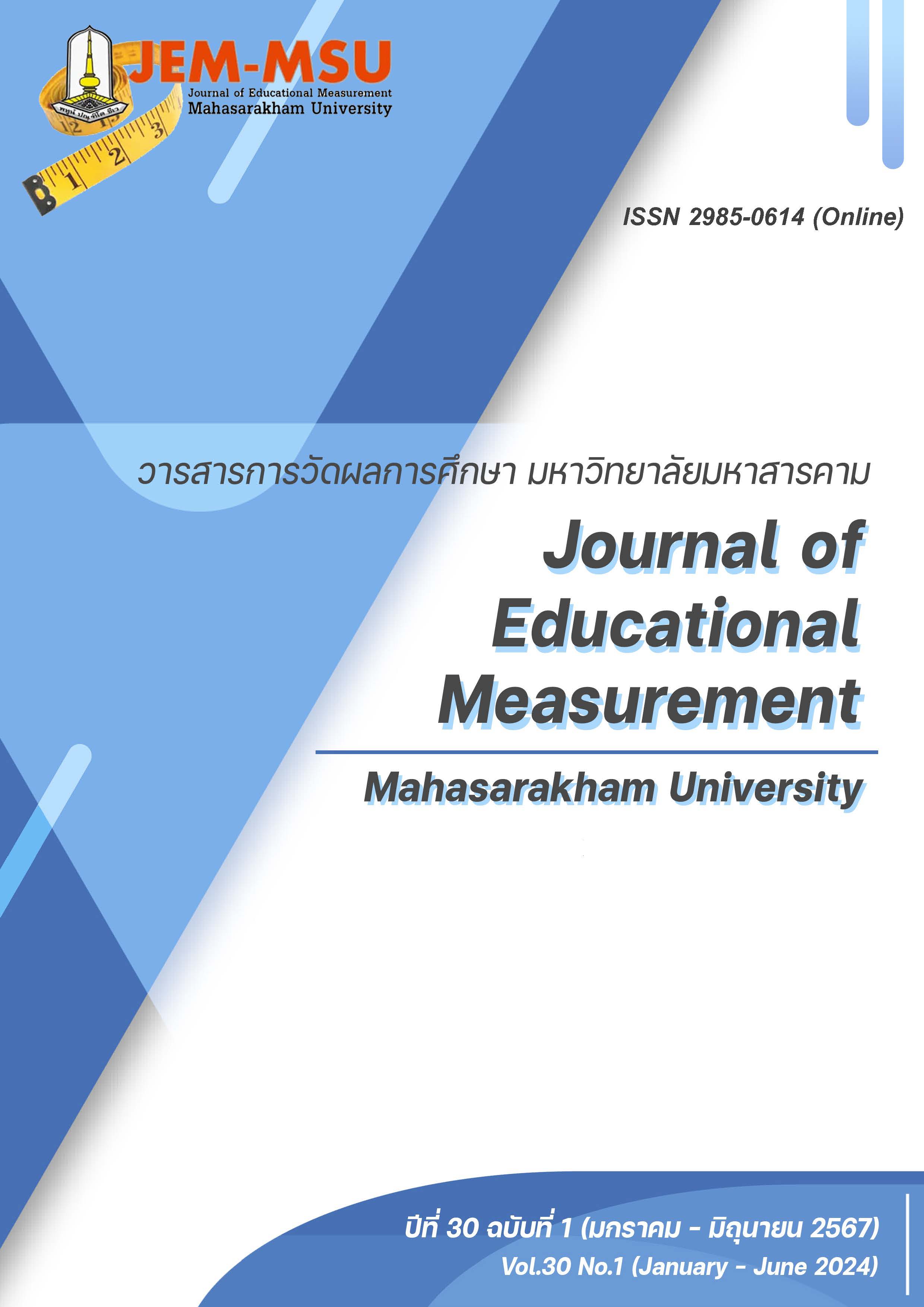Meta-Analysis of the Effective Learning Activities Model On Students' Problem-Solving Thinking: Propensity Score Matching
Main Article Content
Abstract
The research aimed to: 1) investigate the effect sizes and research characteristics that influence students' problem-solving thinking, and 2) compare the effect sizes of the learning activity model to develop students' problem-solving thinking after adjusting the propensity score matching. Thirty-five graduate-level research papers published from 2002 to 2022 were studied. Data were gathered, using a form for recording research characteristics and an assessment form for assessing research quality. Effect sizes were calculated, using Glass's method, and the data were analyzed, using random effects, fixed effects, meta-regression, and propensity score matching techniques. The research findings revealed that:
1) Researches focusing on learning management models significantly influenced students' problem-solving abilities at a high level ( = 1.395). The research characteristics with 4 variables—the university producing the research, the field, the total duration, and the quality—significantly influenced students' problem-solving thinking at a statistically significant level of .05; and 2) after adjusting the propensity score matching, it was found that inquiry-based learning had the greatest impact on students' problem-solving thinking. Designing learning activities that allow students to explore problems, create understanding, expand their thinking through collaborative discussion, and assess outcomes according to the appropriateness of each context will improve students' problem-solving thinking.
Article Details

This work is licensed under a Creative Commons Attribution-NonCommercial-NoDerivatives 4.0 International License.
The content and information contained in the published article in the Journal of Educational Measurement Mahasarakham University represent the opinions and responsibilities of the authors directly. The editorial board of the journal is not necessarily in agreement with or responsible for any of the content.
The articles, data, content, images, etc. that have been published in the Journal of Educational Measurement Mahasarakham University are copyrighted by the journal. If any individual or organization wishes to reproduce or perform any actions involving the entirety or any part of the content, they must obtain written permission from the Journal of Educational Measurement Mahasarakham University.
References
Akkerman, S., Admiraal, W., Brekelmans, M., & Oost, H. (2008). Auditing quality of research in social sciences. Quality & Quantity, 42, 257-274. https://doi.org/10.1007/s11135-006-9044-4
Austin, P. C. (2009). The relative ability of different propensity score methods to balance measured covariates between treated and untreated subjects in observational studies. Medical Decision Making, 29(6), 661-677. https://doi.org/10.1177/0272989X09341755
Bai, H. (2011). A comparison of propensity score matching methods for reducing selection bias. International Journal of Research & Method in Education, 34(1), 81-107. https://doi.org/10.1080/1743727X.2011.552338
Benedetto, U., Head, S. J., Angelini, G. D., & Blackstone, E. H. (2018). Statistical primer: propensity score matching and its alternatives. European Journal of Cardio-Thoracic Surgery, 53(6), 1112-1117. https://doi.org/10.1093/ejcts/ezy167
Borenstein, M., Hedges, L. V., Higgins, J. P., & Rothstein, H. R. (Eds.). (2021). Introduction to meta-analysis. John Wiley & Sons.
Card, N. A. (2012). Applied meta-analysis for social science research. The Guilford Press.
Cooper, H., Hedges, L. V., & Valentine, J. C. (2019). The handbook of research synthesis and meta-analysis (3rd ed.). Russell Sage Foundation. https://doi.org/10.7758/9781610448864
Czodrowski, P. (2014). Count on kappa. Journal of Computer-aided Molecular Design, 28, 1049-1055. https://doi.org/10.1007/s10822-014-9759-6
Dewey, J. (2022). How we think. DigiCat.
Egger, M., Smith, G. D., Schneider, M., & Minder, C. (1997). Bias in meta-analysis detected by a simple, graphical test. BMJ, 315, 629-634. https://doi.org/10.1136/bmj.315.7109.629
Eisenkraft, A. (2003). Expanding the 5e model. The Science Teacher, 70(6), 56–59.
Glass, G. V. (1976). Primary, secondary, and meta-analysis of research. Educational Researcher, 5(10), 3-8. https://doi.org/10.3102/0013189X005010003
Isaksen, S. G., Dorval, K. B., & Treffinger, D. J. (2010). Creative approaches to problem solving: A framework for innovation and change. SAGE publications.
Itsarangkul-Na-Ayutthaya, T., & Damrongpanit, S. (2022a). A meta-analysis of instructional management models affecting creative thinking development. European Journal of Educational Research, 11(4), 2069-2085. https://doi.org/10.12973/eu-jer.11.4.2069
Itsarangkul-Na-Ayutthaya, T., & Damrongpanit, S. (2022b). A meta-analysis of instructional management model for students' creative thinking development: An application of propensity score matching. European Journal of Educational Research, 11(4), 2429-2444. https://doi.org/10.12973/eu-jer.11.4.2429
Johnson, D. W., & Johnson, R. T. (2009). An educational psychology success story: Social interdependence theory and cooperative learning. Educational researcher, 38(5),
-379. https://doi.org/10.3102/0013189X09339057
Mayer, R. E. (2019). Problem solving. Oxford Research Encyclopedia of Education. https://doi.org/10.1093/acrefore/9780190264093.013.860
National Research Council. (2012). Education for life and work: Developing transferable knowledge and skills in the 21st century. National Academies Press.
Rosenbaum, P. R., & Rubin, D. B. (2023). Propensity scores in the design of observational studies for causal effects. Biometrika, 110(1), 1-13. https://doi.org/10.1093/biomet/asac054
Thornton, A., & Lee, P. (2000). Publication bias in meta-analysis: its causes and consequences. Journal of Clinical Epidemiology, 53(2), 207-216. https://doi.org/10.1016/S0895-4356(99)00161-4
Van Houwelingen, H. C., Arends, L. R., & Stijnen, T. (2002). Advanced methods in meta analysis: multivariate approach and meta‐regression. Statistics in Medicine, 21(4), 589-624. https://doi.org/10.1002/sim.1040
Vevea, J. L., Coburn, K. M., & Sutton, A. J. (2019). Publication bias. In H. Cooper, L. V. Hedges, & J. C. Valentine (Eds.), The handbook of research synthesis and meta-analysis (3rd ed., pp. 383-429). Russell Sage Foundation. https://doi.org/10.7758/9781610448864.21
Khunchana, W. (2007). Meta-analysis of research on student's problem solving skills. [Master’s thesis]. Chulalongkorn University. (in Thai)
Susaorat, P. (2010). Cognitive Development (5th ed.). 9119 Technique Printing Co., Ltd. (in Thai)


